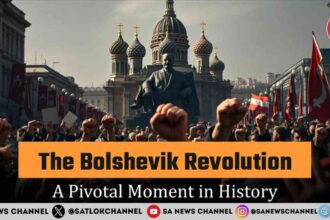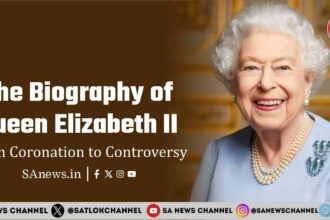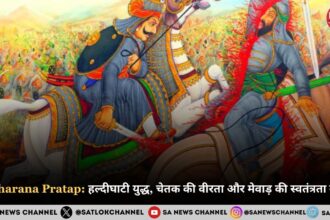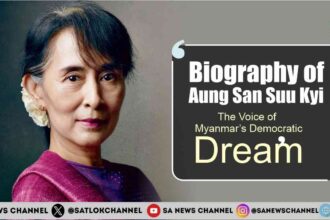In the heart of Southeast Asia, there is a shining city-state that is a global center for finance, technology, and trade. Singapore, with its modern buildings, very clean streets, and excellent facilities, is proof of what people can achieve. But this bright city was not created by luck. It was built during difficult times, brought to life by the firm and often strict vision of one man: Lee Kuan Yew.
- The Making of a Leader: From a British Colony to Cambridge University
- The World of Politics: The Rise of the People’s Action Party
- Building a Nation in a Time of Crisis
- The Singaporean Miracle: From a Poor Country to a Rich One
- The Iron Fist: The High Price of Progress
- An Elder Leader and a Lasting Legacy
- The Tilled Soil
- FAQs
Known as the founding father of modern Singapore, Lee Kuan Yew (1923-2015) was a complex leader who had a great effect on his country. For over thirty years as prime minister, he guided a small, resource-poor island with a divided population from being an unsafe, newly independent nation to the height of global wealth.
His story is not just about one man. It is the story of how a nation made an unlikely journey from being a poor ‘Third World’ country to a rich ‘First World’ one. This is the story of the leader who, with a strong will and a practical plan, built a nation. The story of Lee Kuan Yew cannot be written without writing the story of Singapore’s rise to fame and power.
The Making of a Leader: From a British Colony to Cambridge University
Born on September 16, 1923, into a Chinese family that had lived in British-ruled Singapore for three generations, Harry Lee Kuan Yew grew up where British rule was a normal part of life. His first language was English, which showed his family’s middle-class, English-speaking background. This upbringing gave him a special ability to understand both the East and the West, a skill that would be very useful in his political career.
His education in Singapore’s top schools was suddenly stopped by the Japanese occupation during World War II. The three and a half years of harsh military rule were an experience that shaped him. It destroyed the idea that the British could not be defeated and taught him that survival depended only on one’s own strength. He saw for himself how power, not high principles, decided what happened.

After the war, Lee went to England to study, first at the London School of Economics and then at Fitzwilliam College, Cambridge, where he studied law. He was a brilliant student and graduated with top honors. But his time in Britain was not just for studies; it was when he became aware of politics. He abandoned respect for the British rulers and aligned with growing anti-colonial sentiment and the socialist ideas that were popular in Britain after the war.
He saw how the British lived in their own country and became sure that Singaporeans could govern themselves just as well. He returned to Singapore in 1950, not just as a lawyer, but as a man with a purpose.
The World of Politics: The Rise of the People’s Action Party
When he returned, Singapore was a place of great political activity. The British Empire was getting weaker, and more people were demanding the right to rule themselves. Lee did not join the politics of the rich and powerful. Instead, he became known as a legal adviser for trade unions, fighting for postal workers and other laborers. By working with ordinary people, he earned a reputation as a fighter for the common man and built an important base of support.
He smartly understood that to get independence, he needed the support of many different groups. In 1954, with a group of English-educated nationalists who thought like him, he started the People’s Action Party (PAP). In a very clever and practical political move, Lee made a temporary alliance with pro-communist groups who had a lot of influence over the Chinese-speaking population. Even though he was strongly against communism, he knew he could not win without them. It was a risky plan, like “a ride on the back of a tiger,” as he later said.
In 1955, under a new system that allowed more elected members, Lee won a seat in the government for the Tanjong Pagar area, a district he would represent for the rest of his life. Through clever negotiations and non-stop campaigning, Lee and the PAP established themselves as the best choice for a self-governing, non-communist Singapore.
Building a Nation in a Time of Crisis
The PAP’s clear win in the 1959 general election, where they won 43 out of 51 seats, made Lee Kuan Yew the prime minister. Showing his usual determination, he refused to take the job until the British freed his PAP colleagues who were in jail. On June 5, 1959, at the age of 35, he became the first prime minister of a self-governing Singapore.
He faced huge problems right away: many people were jobless, there was a big shortage of houses, and society was divided into different groups. His first five-year plan was bold and daring. It included rebuilding cities, starting new industries, and freeing women from old restrictions.

However, Lee strongly believed that Singapore could not survive for long on its own. He saw joining the resource-rich Federation of Malaya as the only workable way forward. He argued strongly that a common market and shared security were necessary for the area’s stability and wealth. After dealing with difficult political situations and removing the communist members from his party, Lee led Singapore to join the new Federation of Malaysia on September 16, 1963.
But this union was sure to fail from the beginning. The PAP wanted a “Malaysian Malaysia,” a society where all races were equal and people succeeded based on their ability. This idea clashed completely with the central government’s policy, which gave special advantages to the ethnic Malay majority. Political tensions grew and led to deadly riots between races on the streets of Singapore in 1964. The difference in their beliefs was too big.
Also Read: From Coronation to Controversy: The Biography of Queen Elizabeth II
On August 9, 1965, the Malaysian Parliament voted to remove Singapore from the federation. Lee had worked very hard for the merger, and its failure was a huge disappointment. In a televised press conference that became a famous moment in the nation’s history, Lee started crying as he spoke about the failure of his dream of a multiracial country.
“For me, it is a moment of anguish,” he said with difficulty, “because all my life… my whole adult life, I have believed in merger and the unity of these two territories.” Singapore was forced to become independent, something it had never wanted.
The Singaporean Miracle: From a Poor Country to a Rich One
Left alone, Singapore was an unusual nation created by accident. It had no natural resources, no shared identity, and not even enough water. Surrounded by larger, sometimes unfriendly neighbors, its survival was not certain. Lee Kuan Yew and his government had a clear and difficult choice: fail or create a miracle. They chose to create a miracle.
The Plan for Economic Success
Lee’s way of doing things was practical and without emotion. He threw away old socialist ideas and used whatever worked. He knew that the old trading business was not enough, so he started a big program of building industries to sell goods to other countries. The plan was to work directly with developed countries instead of just with neighbors.
The government, through its Economic Development Board (EDB), tried very hard to attract foreign companies. They made an attractive offer: tax benefits, fair laws, peace in factories without strikes, and most importantly, a hard-working, English-speaking workforce. In an unstable area, Lee turned Singapore’s good location from just a port into a stable, efficient, and corruption-free center for global business.
The results were amazing. From 1965 to 1990, Singapore’s economy grew by almost 9% every year. The average income per person (GDP per capita) was only $517 in 1965. By the time he left the prime minister’s office, it had risen to over $12,000. Jurong, once a swamp, was transformed into a major industrial hub, a symbol of the nation’s new strength.
Building a United Society
Economic success was only one part of Lee’s plan for building the nation. The other part was creating a united society from a mix of different types of immigrants.
The most important part of this social change was public housing. The Housing & Development Board (HDB), started in 1960, began one of the world’s most successful housing programs. It cleared the slums and moved people into modern high-rise apartments. A rule called the Ethnic Integration Policy made sure there was a mix of Chinese, Malay, and Indian families in every building. This was carefully planned to make people from different races live together and stop separate ethnic areas from forming. Today, over 80% of Singaporeans live in HDB flats, and most of them own their homes.
Education was changed to help the country. Lee created a system where people succeeded based on ability, with a focus on speaking two languages. English was made the language for government and business to connect Singapore to the world. At the same time, students had to learn their mother tongue (Mandarin, Malay, or Tamil) to keep their cultural identity.
To solve the big problem of security, Singapore started compulsory military service for all male citizens in 1967. This National Service was not just for defense. It was a powerful way to build the nation by forcing young men from different racial and social backgrounds to live, train, and work together. This helped create a feeling of being one nation.
The Iron Fist: The High Price of Progress
The Singaporean miracle had a price. Lee Kuan Yew was a strict ruler and did not apologize for it. He believed that for a new and diverse nation like Singapore, a Western-style democracy with lots of freedom was a luxury it could not afford. He argued that discipline was the most important thing for survival and progress.
His way of governing has been called a “nanny state” by some and an “iron fist” by others. The PAP controlled politics, and Opposition parties were systematically weakened. Lee and other PAP leaders often used strict laws against personal attacks (defamation) to sue and often make their political opponents and critical journalists lose all their money.
The Internal Security Act, a law from the British colonial times, allowed the government to hold people in jail without a trial for an unknown time. It was used to stop supposed communist threats.
The media was tightly controlled. Newspapers and TV stations were expected to support the government’s goals. Lee’s government also ran social campaigns that controlled many parts of life, from teaching people to be polite and clean to banning long hair on men and starting the famous “Stop at Two” family planning policy in the 1970s.
Lee always defended his actions. He once famously said, “Whoever governs Singapore must have that iron in him. Or give it up. This is not a game of cards. This is your life and mine.” For him, the choice was clear: personal freedoms were less important than security, stability, and wealth for everyone.
An Elder Leader and a Lasting Legacy
Lee Kuan Yew stepped down as prime minister in November 1990 after 31 years. He made sure the change of leaders to his deputy, Goh Chok Tong, was smooth and stable. But he did not leave politics. He stayed in the government, first as Senior Minister and later as Minister Mentor, a title created just for him. He continued to have a lot of power.
His advice was wanted by his successors and by world leaders who were impressed by the Singapore model. His son, Lee Hsien Loong, became the nation’s third prime minister in 2004.
When Lee Kuan Yew died on March 23, 2015, at the age of 91, the whole country of Singapore showed a level of sadness that had never been seen before. Hundreds of thousands of people waited in line for hours, often in heavy rain, to pay their last respects.
His legacy is huge but also debated. He is praised for turning Singapore into a safe, rich, and honest nation with excellent education, healthcare, and public facilities. Singapore is always ranked as one of the top countries in the world for income per person, being a good place to do business, and quality of life. He created a stable and safe place in an unstable region.
However, critics point out that he stopped people from disagreeing with the government, limited political freedom, and created a society that can feel too controlled and practical, with less room for creativity and personal choice. The main question his legacy leaves behind is: Is giving up certain freedoms a fair price to pay for unmatched security and wealth?
Lee Kuan Yew was a leader right for his time and place, a great political figure who succeeded against all odds. He was a tough, practical man, a leader with a great vision, and a strong patriot who was focused on one single thing: the survival and success of Singapore. He did not just lead a nation; he shaped its very character. The shining city-state of Singapore today is his permanent memorial.
The Tilled Soil
It is indisputable that Lee Kuan Yew was a formidable leader who established a path of prosperity for millions of Singaporeans. However, from a spiritual perspective, there remains a path that worldly achievements alone do not tread: the path of salvation through true devotion. While a majority of Singaporeans identify as Buddhist, Lee Kuan Yew himself was an agnostic. He once stated, “I am not an atheist. I do not know whether there is a God or not, but I think it is better to live as if there is.”
This mindset offers a profound illustration of the “tilled soil” analogy, as described by Saint Rampal Ji Maharaj in his sacred book, Jeene Ki Rah (The Way of Living). According to this teaching, virtuous individuals like Lee Kuan Yew, who are not tainted by worldly sins and are considered ideal humans, are like a well-prepared field. For this tilled soil to bear a crop, the seed of true devotion must be sown. Otherwise, the field will eventually be overrun by random weeds and parasitic plants—analogous to humans following misguided paths of worship, thereby losing their precious time and spiritual merit (punyas).
This philosophy suggests that it was such misguided paths that led historical figures like Buddha to lose faith in a supreme, interventionist God, from which an entire religion centered on self-transformation arose. This aligns with a famous teaching by Kabir Saheb: “Ved Kateb jhoothe nahi bhai, jhoothe hain jo samjhe naahi”, which translates to, “The holy scriptures are not false; false are those who fail to comprehend their true meaning.”
Following the timeless wisdom of Kabir Saheb, Sant Rampal Ji Maharaj is today presenting the true path of devotion, which is alluded to in the holy scriptures of all religions. This is the only path wherein it is proven that the Supreme God can and will absolve all of a devotee’s sins, as sanctioned in the Yajurveda, Adhyaya 8, Mantra 13. The foundation of this path is the understanding that true salvation lies in the worship of the Supreme God Kabir.
Lee Kuan Yew’s agnosticism was tinged with a deep human longing. He once expressed a hope for an afterlife where he could be reunited with his wife, framing it as a human desire rather than a belief based on faith. This sentiment touches upon a fundamental question: why do humans desire eternal life with their loved ones?
The answer, as explained in the true story of creation (Shrishti Rachna), is that our original home is Satlok—an eternal and immortal realm where we lived with our families in perfect harmony. Our present desires are a faint memory of our true origin. So why are we here now, to understand that Read: How were the Souls Caught in Kaal’s (Brahm, Satan, Shaitan, Devil) Trap? – Jagat Guru Rampal Ji.
Mankind was trending towards agnosticism and atheism because the benefits of devotion promised by prevalent traditions were not being realized. Sant Rampal Ji Maharaj has clarified the spiritual landscape, revealing the true path and the correct method of worship to attain the ultimate benefits that every soul truly seeks.
FAQs
1) What was Lee Kuan Yew famous for?
Ans: Lee Kuan Yew was famous for being the first Prime Minister of Singapore and for transforming the country from a small, developing nation into one of the world’s wealthiest and most modern city-states in a single generation.
2) Was Lee Kuan Yew Malaysian?
Ans: No, he was Singaporean. He was born in Singapore when it was a British colony. For a brief period from 1963 to 1965, when Singapore joined the Federation of Malaysia, he and other Singaporeans were Malaysian citizens. After Singapore’s separation in 1965, he remained a Singaporean citizen.
3) Who is the father of Singapore?
Ans: Lee Kuan Yew is widely regarded as the founding father of modern Singapore for his central role in its independence and development.
4) Could Lee Kuan Yew speak Chinese?
Ans: Yes. While his first language was English, he made a great effort to learn and became fluent in Mandarin Chinese as a politician to connect with the Chinese-speaking majority. He also learned Malay and some Hokkien.
5) Was Singapore a British colony?
Ans: Yes. From 1819 until 1959, Singapore was under British rule, eventually becoming a Crown Colony. It gained self-governance in 1959 and became a fully independent nation on August 9, 1965.
6) When was Lee Kuan Yew born?
Ans: Lee Kuan Yew was born on September 16, 1923.
7) When did Lee Kuan Yew Die?
Ans: Lee Kuan Yew died on March 23, 2015.









